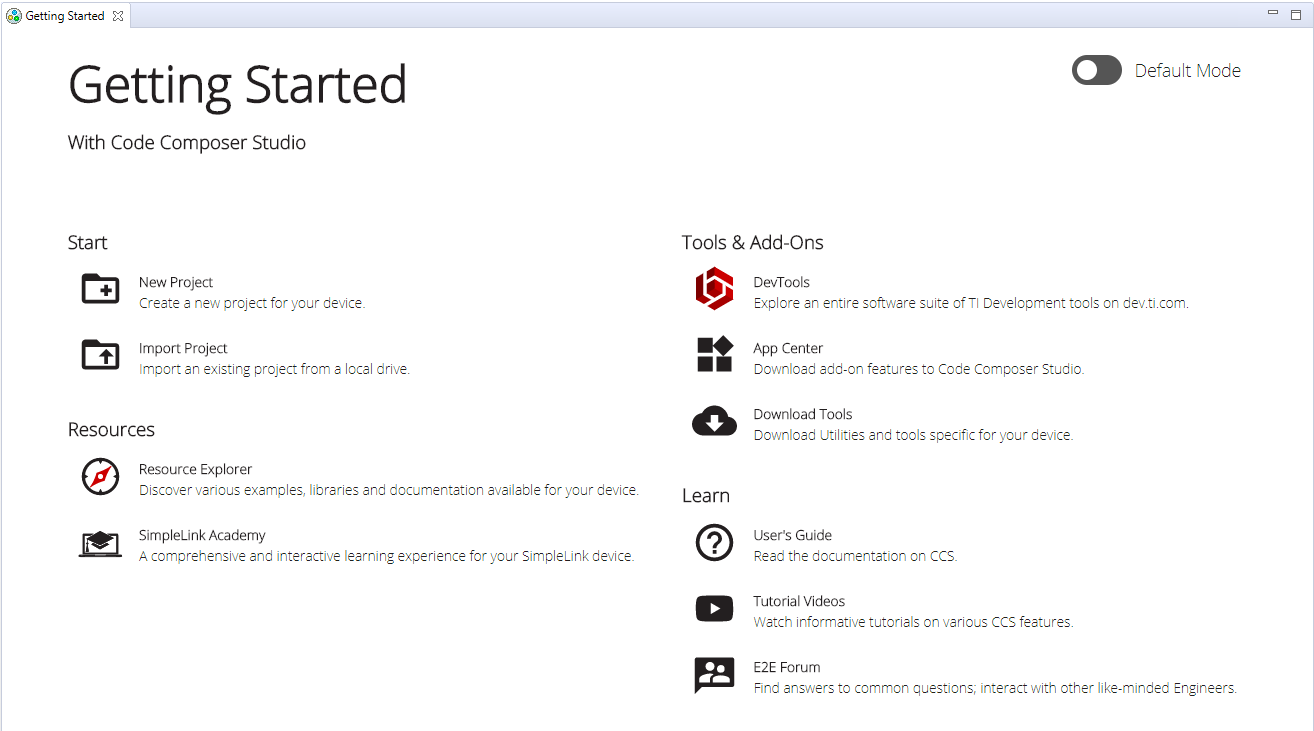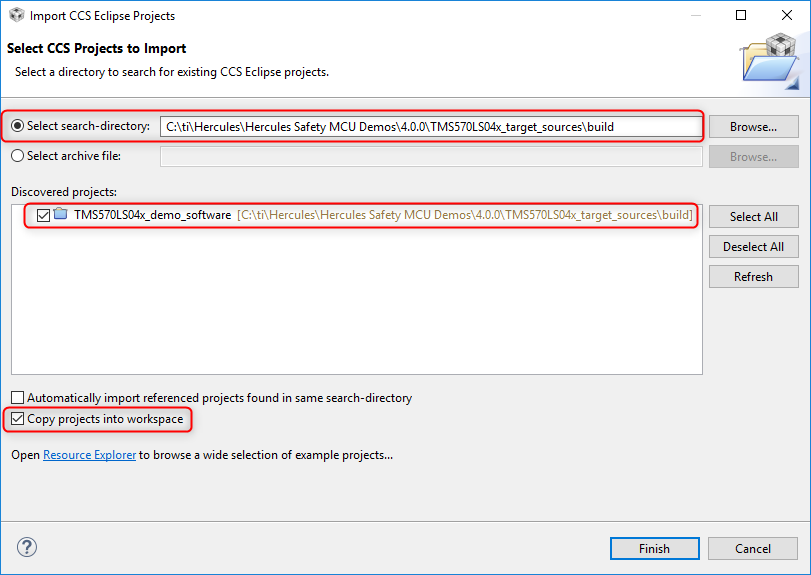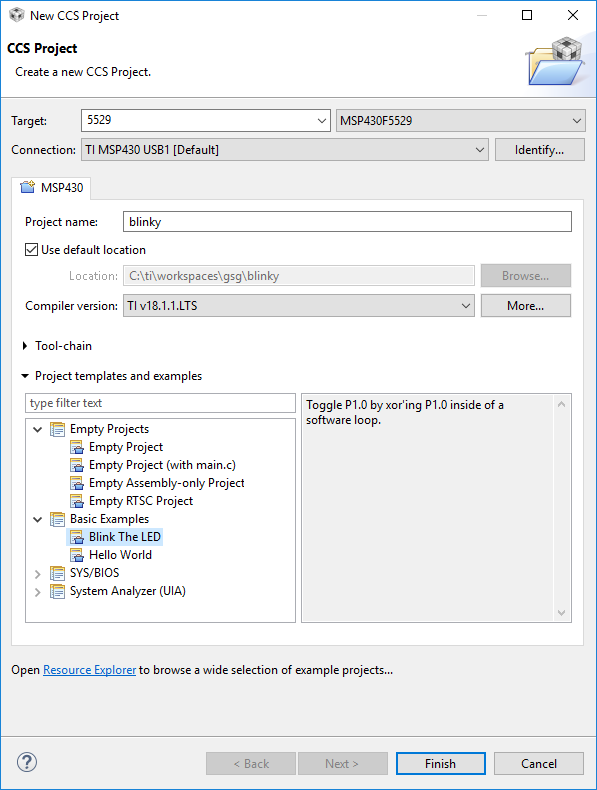4.1. Get Started View¶
First time users of Code Composer Studio™ should start with the aptly named Get Started view. The Get Started view is the first screen that is visible when Code Composer Studio is launched for the first time. The view can also be explicitly opened via the Help → Get Started menu item.
The purpose of the Get Started view is to provide fast access to common actions and tasks, especially those that are relevant when first starting to use Code Composer Studio. This includes browsing examples and documentation, importing example projects, changing the IDE theme, and so forth:

If you have a valid TI kit (such as a LaunchPad Development Kit) connected to your computer, the Getting Started view may be able to autodetect it. If autodetect is successful, it will be displayed under the Get started section of the view along with other relevant links for the target. If no target is autodetect, one can be manually selected by using the dropdown menu under the Get started section. Text can also be manually entered in the associated field to filter the options in the dropdown list.
4.2. Resource Explorer¶
The Resource Explorer helps you find all the latest examples, libraries, demo applications, data sheets, and more for your chosen platform.
Hint
The Code Composer Studio Academy is available from Resource Explorer. Explore the Code Composer Studio Academy for additional resources on Code Composer Studio.
The Resource Explorer can be opened by selecting Browse Software and examples under Start exploring in the Getting Started view or from the View → Open Resource Explorer menu item.

Filtering by device, or by TI LaunchPad Kit, the interface enables you to filter the content to only what is relevant to your chosen platform.
Use the Filter by Board or Device filter field to search and select the device or TI LaunchPad Kit that you are using. For example, if you are using the LP-MSPM0G3507, you can starting typing "G3507" in the search field to filter the list to easily find your LaunchPad:

If you have a valid TI kit (such as a LaunchPad Development Kit) connected to your computer, Resource Explorer may be able to autodetect it. If autodetect is successful, you can select the USE MY BOARD option to specify your kit:

Once your device or TI LaunchPad Kit is selected, the filter will be applied and only content relevant to your selection will be displayed. You can now browse through the displayed content to learn more about your device, board, relevant tools, and available software packages. Note the additional filters to display examples based on Kernel, Compiler, etc.

The best way to get going with software development on your target is to start with some existing examples for your target. Many examples are included with the software package with supports your device, and many of these software packages are accessible right from Resource Explorer.
Note
Not all devices are supported via Resource Explorer.
4.3. Importing a Code Composer Studio Project¶
Code Composer Studio projects must be imported into the current Code Composer Studio workspace before they can be used. The most convenient way to import example Code Composer Studio projects is from Resource Explorer, as mentioned in some of the sections above.
The project can also be manually imported using the Import Projects wizard:
- Go to menu File → Import Project(s).
- Next to Search directory, click Browse and browse to the location of a project or project spec.
- Select the desired project(s) from the list of Discovered projects.
- Select if the project should be copied to the current workspace folder or left in the original location and add the project folder itself to the environment (creating a Multi-Root Workspace environment).

An alternative way to import a project is to drag it from the system file explorer and drop it directly into the Code Composer Studio Explorer. Once the project has been imported into the workspace, it will be visible in the Explorer.
Warning
Importing a project of the same name as one that already exists in the workspace is not allowed.
Note
Code Composer Studio can import projects that are created with Code Composer Studio versions 4.x and greater. However, bear in mind that the greater the variance in Code Composer Studio version used to create the project vs. the version used to import the project, the more error-prone the import process could be.
If a project created with an older version of Code Composer Studio is imported into the workspace of a newer Code Composer Studio version, the project may be migrated to support the newer version of Code Composer Studio. This may prevent the project from being imported or opened again with the older Code Composer Studio version. This is more likely for major Code Composer Studio revision number differences while minor revision number differences are typically not impacted.
The same rule can also apply when a project created with a newer version of Code Composer Studio is imported into an older version of Code Composer Studio. Code Composer Studio projects are typically not backward compatible in cases with major revision number differences. If you want to use a newer Code Composer Studio project with an older Code Composer Studio version, it is recommended to create a new project in the older Code Composer Studio version and copy over the source files and settings.
For more information on importing Code Composer Studio projects, please refer to the relevant section in the Projects and Build chapter.
4.4. Creating a New Code Composer Studio Project¶
Creating a new Code Composer Studio project purely from "scratch" is typically not recommended. Instead, it is strongly recommended to start with an existing SDK example. There is often a very minimal SDK example which often serves as a template for users wishing to start from "scratch".
- Go to menu File → Create New Project... or open the Getting Started view and select the Create a new project in Code Composer Studio option under the Start developing section of the Getting Started view. This will open the Project Wizard.
- In Project Wizard, specify the board or device under Device and Board. Once a board or device is specified, a list of available projects appears.
- (Optional) Use the additional filter and search fields to further filter the list of available projects.
- Select the desired project to import. Most SDKs provide some sort of empty type example which serves as a basic template for new projects.
- Press IMPORT to start the import process.
- Select the desired toolchain for the project if multiple toolchains are supported. Press NEXT to continue.
- Select the name and specific target for the project. Press NEXT to continue.
- If the associated product(s) for the selected project is not already installed, an additional step will appear to install the required product(s). Follow the instructions to install the required product(s) before continuing. If the associated product(s) is already installed, this step will be skipped.
- The project will now be created/imported and visible in the Explorer view.

Warning
The Project Wizard is based on Resource Explorer and will allow a user to select from a rich variety of device-specific templates from an available online SDK for the device in Resource Explorer. Internet access is required for full access to all the online templates/examples. If internet access is not available, then the user has the option to manually browse for examples from SDKs already installed locally (and detected by Code Composer Studio).
4.5. Building and Debugging Your Project¶
Once your project has been created/imported and any necessary manual changes completed, the project can then be compiled and loaded to the target for execution/debug. There is one easy option to do all this - by selecting the project in the Explorer view and selecting Debug Project in the context menu (or select Run → Debug Project in the top menu bar). This option will automatically do all the below steps by default:
- Save source files (if necessary).
- Build the project (incrementally).
- Start the debugger (Code Composer Studio will switch from the Explorer to the Debug view in the Side Bar).
- Connect Code Composer Studio to the target.
- Load (flash) the program on the target.
- Run to main.

4.6. Using AI Code Assistants¶
AI-powered code assistants are rapidly becoming indispensable for developers - providing suggestions and automated features that help in writing code more efficiently and accurately. As popularity for these features continues to increase, so does the demand for development environments that can provide such functionality. While Code Composer Studio does not provide a custom solution that is optimized for Texas Instruments (TI) content/collateral, general AI code assist functionality is available with Code Composer Studio through various third-party tools - such as the new Theia AI framework, which comes bundled with Code Composer Studio, as well as numerous third-party AI code assist extensions available on Open VSX.
For more information on using these third-party AI code assistant tools in Code Composer Studio, please refer to the following document: Using AI Code Assistants with Code Composer Studio.

